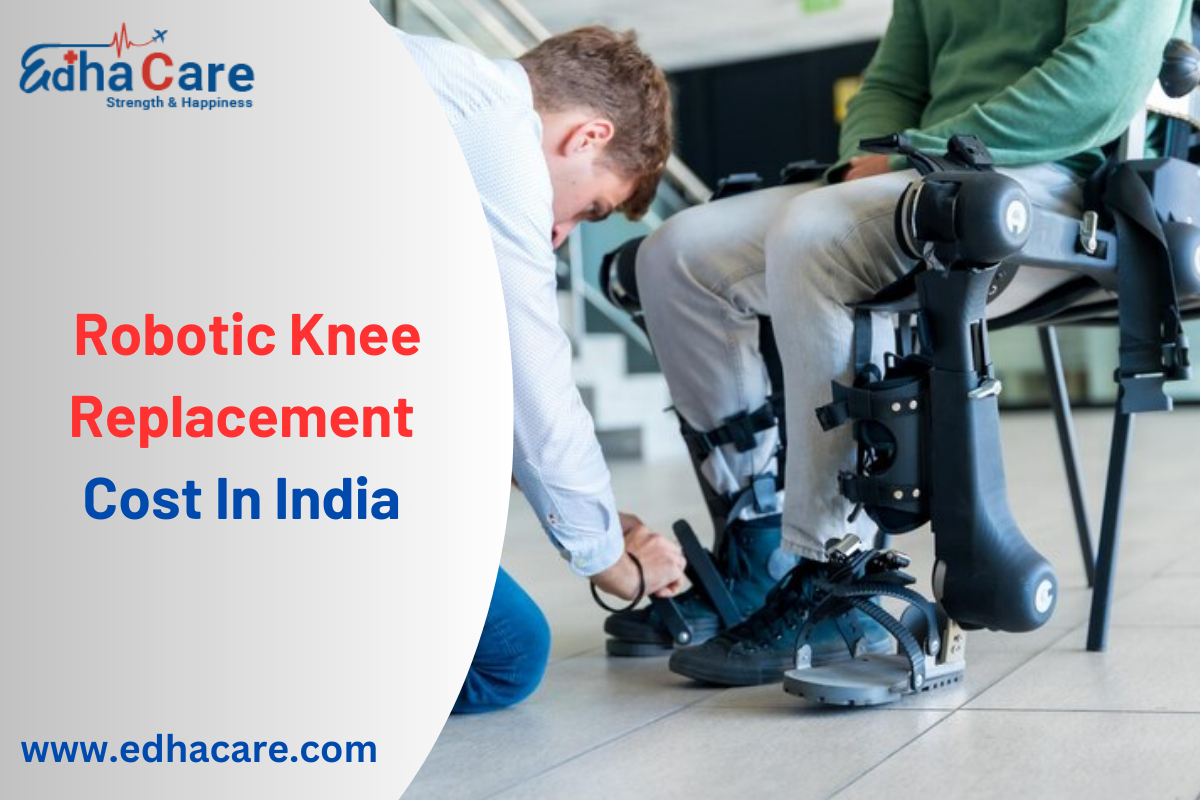In India, total knee replacement surgery is among the most popular surgical procedures. The majority of medical facilities and physicians do traditional knee replacement surgery, which involves manual cutting and alignment of the implant with the femur and tibial bones. Computer-aided alignment is being used in certain institutions. When compared to manual alignment, computer-assisted alignment yields better outcomes.
As of 2019, about ten Indian hospitals had acquired surgical robots to do knee replacement procedures. The expensive cost of approximately 10-15 crores is the cause for the restricted use of this robot in hospitals. Your knee won’t be operated on by the robot. This instrument aids the surgeon in performing the procedure with more accuracy.
Expenses and Physicians

- Purchasing a robot is a significant choice for any facility performing knee replacement surgery. Unless the hospital does a lot of these surgeries, the robot’s cost is a deterrent.
- Robot-assisted procedures offer increased accuracy, faster recovery times, and better outcomes. In more complex cases, a robotically assisted knee replacement offers improved positioning of the joint and increased soft tissue balance surrounding the knee. You don’t need to prepare any differently for robotically assisted knee replacements than for conventional ones.
- In India, the starting cost for an economical robotic knee replacement surgery is INR 3,91,000, or 4,700 USD. Numerous factors can affect the total expense of robotic knee replacement surgery in India. As a result, the package’s overall cost is lower than in other well-known states that offer the same services. India is renowned for its reasonably priced healthcare as well as for having some of the greatest physicians and surgeons for any kind of ailment.
- Depending on the hospital’s discretion, the robotic knee replacement surgery package in India may vary. The expertise and experience of the doctor.
- The condition of the patient: The medical state of the patient and whether other modalities are needed for a thorough course of care.
How long is the hospital stay after knee replacement surgery in India?
- Post-operative care is required.
- The cost of your robotic knee replacement surgery may vary depending on the medical facility and the kind of space you choose.
Parameters Influencing Robotic Knee Replacement Surgery in India
- Depending on the hospital’s discretion, the robotic knee replacement surgery package in India may vary.
- The expertise and experience of the doctor.
- The patient’s condition: the nature of the illness and whether further modalities are needed for an all-encompassing course of care.
- The length of hospitalization and stay required in India for a robotic knee replacement procedure.
- Post-operative care is required.
- The cost of your robotic knee replacement surgery may vary depending on the medical facility and the kind of space you choose.
Different Types of India’s Robotic Knee Replacement Surgery
- The Navio Surgical System
- Mako Robotic-Assisted Knee Surgery
Each approach helps the surgeon to design an effective surgical plan, especially for you. This helps enhance every stage of your surgical procedure.
All of your alternatives will be discussed and reviewed with you by your orthopedic surgeon. Although the robotic tools do the same task, they are not the same in terms of how your knee replacement is planned and carried out.
Both partial and total knee replacement surgeries can be performed with the Navio and Mako devices. The finest solutions will be discussed by your orthopedic surgeon, along with whether you are a good candidate for robotic joint replacement surgery in India.
Who Qualifies for India’s Robotic Knee Replacement Surgery?

Precision and patient satisfaction may both be improved by robotic joint replacement surgery. You can find out if you are a good candidate for robotic knee surgery from the best orthopedic surgeon in India. This is mostly influenced by the patient’s age, way of life, diet, and degree of damage to the joints.
If osteoarthritis has not progressed too far, patients may also be good candidates for robotic knee surgery. Certain individuals experience extreme discomfort, swelling, and stiffness around their knees, which makes it difficult for them to move normally and go about their everyday lives. The patient might be ready for surgery if prescribed medication and physical therapy are unable to reduce discomfort and edema.
How is this surgery performed?
Pre Surgery:
Similar to most patients who have a total knee replacement, you have likely had some prior experience. Unlike traditional knee replacement procedures, knee replacements may employ a sequence of X-rays to produce a three-dimensional (3D) representation of your knee anatomy. The knee replacement surgeon will be able to design several components of your procedure in advance, thanks to the 3D model.
During the surgery:
With robotic assistance, the surgical technique for a robotic complete knee replacement is quite similar to that of a standard knee replacement.
With the help of robotically assisted devices, your orthopedic surgeon has received specialized training to customize the surgical technique to your unique anatomy.
The robot is not able to rotate by itself and requires instructions from the orthopedic surgeon to do so. This makes it more likely that your surgeon’s strategy will be implemented as envisioned.
The robot’s technology gives your surgeon information about your knee during the procedure, which aids in decision-making about the positioning of implants based on your unique anatomy.
Post Surgery:
You will be admitted to the hospital with the orthopedic surgeon’s recovery plan after surgery. While time frames for recovery differ, most patients should be back behind the wheel after two weeks. Your surgeon will advise you on what activities you ought to avoid undertaking and when you may resume them.
The accuracy allows for:
- A more natural sensation after surgery is the result of more accurate implant placement.
- Safety is improved and the likelihood of infection is decreased when there is less danger of harm to the surrounding tissues.
- A quicker recovery and reduced pain are attributed to less blood loss and fewer incisions.
- Early hospital departure, reduced hospital stays, and early recovery
- Possibility of enhanced long-term performance
- Increased longevity and Implant longevity
- Enhancement of quality of Life.
Both partial and total knee replacement surgeries can be performed with the Navio and Mako devices. The finest solutions will be discussed by your surgeon, along with whether you are a good candidate for robotic joint replacement surgery in India.
Top Hospitals in India
- Fortis Hospital Gurgaon
- Indraprastha Apollo Hospital New Delhi
- Manipal Hospital Dwarka, Delhi
- Amrita Hospital, Faridabad
- Global Hospital Mumbai
- MGM Healthcare, Chennai
- Sharda Hospital, Greater Noida
- BGS Gleneagles Global Hospitals, Bangalore
Which Benefits Does It Offer in India?

Robotic-assisted knee Replacement Surgery in India has a number of benefits over traditional surgery. Among the advantages are:
- Improved surgical planning: Specialized 3-D images are taken either before or during the procedure, depending on the robotic option you select. To guarantee the right size and fit, your surgeon will be able to more precisely determine the kind and location of your replacement joint with the help of these photographs.
- Increased accuracy: Your orthopedic surgeon can do more precise planning, tissue removal, and implant placement thanks to robotic technologies. This may lead to shorter recovery periods, fewer problems, and a lower chance of revision surgery.
- The process increases the likelihood of enhancing knee joint function over the long run. Smaller incisions are made throughout the procedure, which helps the patient recuperate more quickly, spend less time in the hospital, and experience less pain.
- As the implant is placed more precisely, the patient will feel more at ease in the joint following treatment. To place the implants accurately, this procedure requires a specialized surgical plan. After the implantation of this prosthesis, there is a lower chance of complications.
Conclusion
The post-treatment discomfort from robotic knee replacement surgery is marginally lower than that from traditional treatments. Minimal knee exposure is necessary to do safe surgery because the robotic arm bone cuts are so precise and prevent damage to wrong structures.
Since the procedure is currently less invasive, you should be able to return home the same day. The majority of patients say that it takes three or four weeks to heal completely. But in some cases, it could take up to six weeks. The orthopedic surgeon will give you thorough instructions for aftercare.
FAQS
Q.1 What Is the Average Wear-Out Period for a Knee Replacement?
A: Most knee replacements last 20 years or longer.
Q.2 What is the average length of time needed for knee replacement surgery?
A: Knee replacement surgery is done under anesthesia and typically requires one to two hours.
Q.3 How can I determine if I require knee replacement surgery?
A: A knee replacement procedure is highly advised if the X-ray results indicate a gap in the knees and you are in pain when you walk. By doing so, the medical condition will not worsen.
Q.4 Is there a maximum age for knee replacements with robotics?
A: There is no upper age limit for Robotic Knee Replacement; it is determined by the stage of arthritis that the patient is experiencing. It gives younger patients more durable implants and a greater degree of mobility.
Book Your Health Appointment with Our Experts – Click to Book Appointment.

